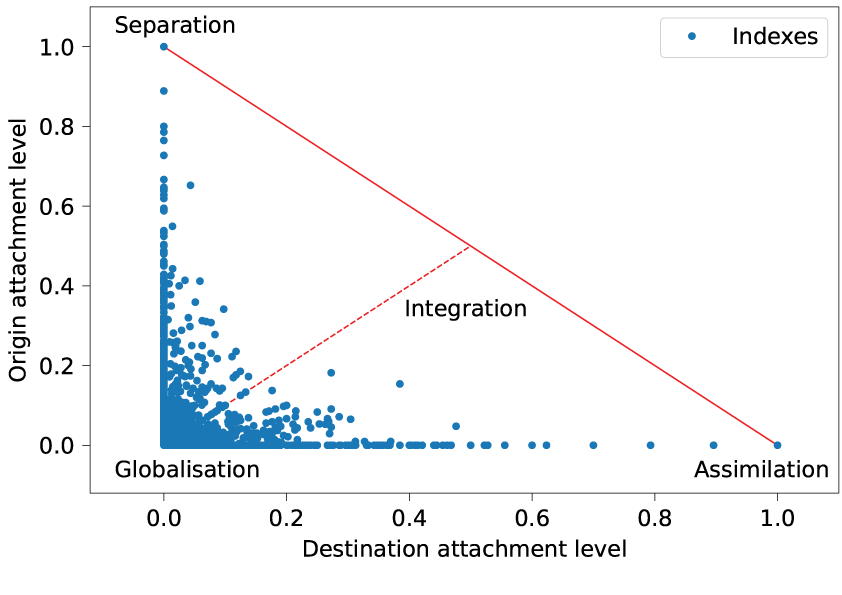Arbeitsbereich
Migration und Mobilität
Auf einen Blick
Projekte
Publikationen
Team
Projekt
Evaluating Immigrants’ Cultural Assimilation by Using Digital Trace Data
Jisu Kim, André Grow-Böser, Asli Ebru Sanlitürk, Emilio Zagheni; in Zusammenarbeit mit René Flores D. (University of Chicago, Vereinigte Staaten), Kiran Garimella (Rutgers, The State University of New Jersey, New Brunswick, Vereinigte Staaten), Ingmar Weber (Saarland University, Saarbrücken, Deutschland), Ilana Ventura (University of Chicago, Vereinigte Staaten)
Ausführliche Beschreibung
Immigrants are expected to assimilate gradually into the host society over generations, and various measures have been developed to assess their assimilation, such as economic success, education, language proficiency, and political engagement. However, measuring cultural assimilation has been challenging due to the lack of suitable data and indicators.
Are immigrants assimilating to the cultural taste of the native population? And how do different subpopulations of immigrants assimilate? According to the "straight-line" assimilation hypothesis, the more time immigrants spend in the host society, the more culturally similar to natives they become. European immigrants to the United States historically assimilated and became culturally indistinguishable from Anglo-American natives by the third generation. However, the post–1965 assimilation of Latin American and Asian immigrants appears "segmented" rather than "linear." Whereas advantaged immigrants are still assimilating "linearly," disadvantaged groups tend to adopt the cultural norms and styles of native minorities, such as African-Americans, due to their concentration in poor neighborhoods.
In this project, we leverage digital trace data and primary data collections in order to provide insight into immigrants' interests and preferences and to complement existing sources. To study cultural assimilation, we use Facebook's advertising platform, which provides estimates of the number of users and their interests revealed online, for different demographic groups, including by country of previous residence.
As a first step toward assessing cultural assimilation with digital trace data, Dubois et al. (2018) proposed a new method to evaluate assimilation processes by using Facebook data. Applying the proposed metric, they found that Turkish immigrants to Germany showed relatively high assimilation, with some subgroups assimilating more than others (e.g., men more than women). Stewart et al. (2019) expanded on this work, using the same metric to evaluate the musical taste of Mexican immigrants to the USA. The authors found that Mexican immigrants tended to assimilate more toward African Americans than toward non-Hispanic whites in the US.
In a related study, Kim et al. (2022) proposed a new approach to measuring two aspects of cultural integration, using Twitter data. These aspects are the origin attachment index, which represents the preservation of links to the origin country and culture, and the destination attachment index, which indicates the creation of new links and the adoption of cultural traits from the new residence country. Using these indexes, they analyzed how immigrants from different countries integrate into host countries, and found that a common language and low proficiency in the host language promote origin attachment.
The next phase of this project further tests patterns of cultural assimilation of Mexican immigrants to the USA, using a survey where respondents are recruited through Facebook’s targeted advertising platform. This online survey tests the validity of the data provided by Facebook, and it provides complementary information that cannot be obtained solely through passively collected Facebook data. In addition, the innovative survey design with referrals to family members would enable us to isolate the role of family characteristics over generations on patterns of cultural assimilation.
Bewertung der kulturellen Integration anhand von Daten aus sozialen Medien

Verhältnis zwischen Herkunfts- und Zielanbindungsindizes für alle Migrant*innen in den Daten, hochgerechnet auf vier Integrationstypen. Hier sind verschiedene Muster für einzelne Nutzer*innen zu beobachten, die zu unterschiedlichen Assimilationstypen führen. Die roten Linien geben einen ungefähren Hinweis auf den Assimilationstyp der Nutzer*innen. Der Winkel jedes Individuums zur x/y-Achse gibt uns zusammen mit der Entfernung vom Ursprung einen Hinweis auf den Assimilationstyp. Ein*e Migrant*in nahe der x-Achse durchläuft höchstwahrscheinlich einen Assimilationsprozess, ein*e Migrant*in nahe der y-Achse durchläuft einen Separationsprozess, während diejenigen, die dazwischen liegen, eine Integration oder Globalisierung durchlaufen. © Kim Jisu, et al. "Origin and destination attachment: study of cultural integration on Twitter." EPJ Data Science 11.1 (2022): 55.
Daten und Erhebungen, Kultur, Migration
Italien, Vereinigte Staaten, Vereinigtes Königreich von Großbritannien und Nordirland, Welt
Publikationen
Gil-Clavel, B. S.; Grow, A.; Bijlsma, M. J.:
MPIDR Working Paper WP-2022-012. (2022)

Kim, J.; Sîrbu, A.; Giannotti, F.; Rossetti, G.; Rapoport, H.:
EPJ Data Science 11:55, 1–20. (2022)

Alburez-Gutierrez, D.; Aref, S.; Gil-Clavel, B. S.; Grow, A.; Negraia, D. V.; Zagheni, E.:
In: Smart statistics for smart applications : book of short papers SIS2019, 23–30. Pearson. (2019)

Stewart, I. B.; Flores, R. D.; Riffe, T.; Weber, I. G.; Zagheni, E.:
In: Proceedings of the World Wide Web Conference WWW 2019: May 13-17, 2019, San Francisco, CA, USA, 3258–3264. New York: ACM. (2019)

Dubois, A.; Zagheni, E.; Garimella, K.; Weber, I. G.:
In: Social Informatics: 10th International Conference, SocInfo 2018, St. Petersburg, Russia, September 25-28, 2018, Proceedings, Part II, 51–60. Cham: Springer. (2018)